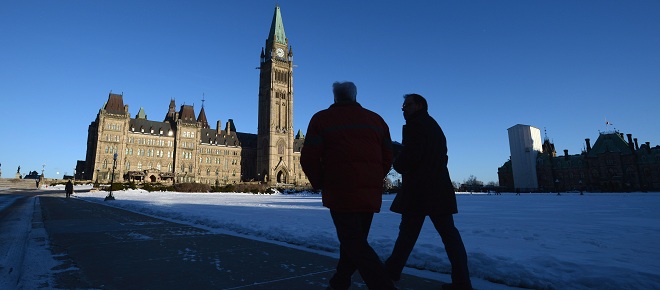Budget may aim to close tax loopholes, which isn’t as easy as it seems
Stephen Gordon on fixing outdated tax credits
Men chat as they walk up Parliament Hill to the centre block in Ottawa, Thursday January 17, 2013. THE CANADIAN PRESS/Sean Kilpatrick
Share

Finance Minister Jim Flaherty has dropped hints to the effect that the March 21 budget will include efforts to revisit the system of tax expenditures: the deductions, exemptions and credits for various activities, firms and people. Eliminating tax loopholes always sounds like a good idea, but it’s not always obvious what the distinction is between a loophole and an integral part of a well-designed tax system.
The largest single item in the 2012 edition of the Department of Finance’s report on tax expenditures is the basic personal amount deduction: more than $30 billion in foregone tax revenues. There is no way the government will remove this tax deduction, nor should it: public finance theory recommends a deduction covering the minimal income required to sustain a basic existence. Other big-ticket items include the system of RRSPs ($15 billion) and exemption of groceries from the GST ($3.9 billion). You can see why the business of eliminating loopholes is not simply a matter of wiping the slate clean. There are a lot of babies in that bathwater.
This is not to say the current system is perfect; far from it. The most pressing problem is transparency. After a tax expenditure has been implemented, it pretty much disappears from view—they don’t show up in the budget items, and they are not subject to any formal process of review. Some of those measures are probably designed to solve problems that no longer exist.
Many tax expenditures are spending in all but name: the working-income tax benefit is best thought of as a transfer to low-income households, but up until last year it was classified as a tax expenditure. There are many, many other tax expenditures indistinguishable from regular spending measures—think of the children’s art tax credit and other boutique tax credits that have become a trademark of Conservative budgets. But since these programs are classified as tax expenditures, they can be marketed as “tax relief” and not “increased spending.”
Perhaps the best way to proceed is to pick up on a suggestion of John Lester in a paper published by the University of Calgary’s School of Public Policy: integrate tax expenditures into departmental budgets and treat them in the same way they treat regular expenditures. For example, the various business tax credits would be included in the budget of Industry Canada and the tax expenditures for video and film production would be part of Heritage Canada’s budget. It would then be up to the various departments to decide if the expenditures were in fact the most efficient way of achieving their policy goals.
Stephen Gordon is professor of economics at the University of Laval in Quebec City, and a regular contributor to the Econowatch blog at Macleans.ca